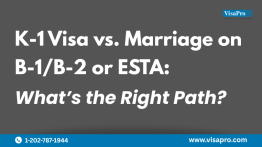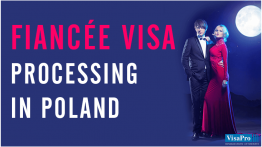Quick Summary:
If extraordinary or unexpected circumstances have prevented you from meeting your foreign fiancé, a K-1 visa may still be possible. While meeting requirements can seem overwhelming, experienced immigration attorneys can help you explore exemptions or creative solutions that may be more accessible for both of you.
Understanding K-1 Visa Requirements
The main K-1 visa requirements are: both parties should be legally free to marry, intend to marry within 90 days of arrival in the U.S., and the couple has met in person within two years preceding the filing of the Form I-12F.
The I-129F requirements are central to the process. Along with proving citizenship and relationship evidence, you must include documentation of your in-person meeting. Without it, USCIS will likely issue a denial unless you qualify for one of the exceptions.
Regarding the in-person meeting, the law requires proof of a face-to-face meeting.
However, USCIS has allowed for exceptions to this very important rule. These narrow exceptions allow for situations that arise from extreme hardship or strict cultural practices. Understanding these exceptions can provide hope during what feels like an impossible situation.
When couples face genuine barriers to meeting, whether due to health conditions, travel restrictions, or other extraordinary circumstances. The key is demonstrating that your inability to meet is legitimate and well-documented, not simply a matter of convenience or preference.
The Medical Exemption: When Health Issues Prevent Travel
Immigration law provides an exemption to the K-1 visa meeting requirement when the U.S. citizen petitioner cannot travel due to documented medical conditions. This exemption requires substantial evidence proving that travel is genuinely an extreme hardship, not merely difficult or uncomfortable.
To qualify for a medical exemption, you’ll need comprehensive medical documentation from licensed physicians clearly stating that travel is medically inadvisable or extremely difficult. The documentation must be specific about why travel poses risks to your health and/or creates other hardships and should ideally come from specialists treating your condition. Generic statements about travel being “not recommended” typically won’t suffice.
The medical exemption process also requires demonstrating that your relationship is genuine despite the lack of in-person meetings. This means providing extensive evidence of your ongoing communication, relationship development, and commitment to marriage. Immigration officers will scrutinize these cases more carefully since the traditional meeting requirement serves as evidence of a bona fide relationship.
Documentation Requirements for Medical Exemptions
Successfully obtaining a medical exemption requires thorough preparation and documentation. Your medical records should clearly establish:
- Specific diagnoses that prevent travel or make it extremely difficult
- Treatment history showing ongoing medical care
- Physician statements explicitly stating travel is medically contraindicated
- Specialist consultations supporting the travel restriction
Additionally, you’ll need to provide compelling evidence of your relationship’s authenticity through detailed communication logs, photos, video call records, and testimony from friends and family who can verify your relationship’s legitimacy.

Creative Meeting Solutions: The B-2 Visa or Third Country Options
If you haven’t met your fiancé(e) in person, you have 2 options – request a waiver if you qualify, have your fiancé(e) come to the U.S. to meet you or arrange an in-person meeting in a third country.
The Visitor Visa
While your fiancée may not have applied for a visitor visa yet, this is worth exploring. If they can secure a B-2 visa or travel on Visa Waiver, they can visit you in the U.S., satisfy the meeting requirement, and then you can proceed with the K-1.
Tourist visas can provide excellent opportunities for couples to meet while building stronger K-1 cases. However, this strategy requires careful consideration of timing and documentation to avoid complications.
The key challenge with B-2 visas for fiancé(e)s is demonstrating nonimmigrant intent, i.e., proving that your partner intends to return to their home country after visiting. This becomes more complex when there’s an obvious romantic relationship and potential future immigration plans. Success requires showing strong ties to the home country through employment, property ownership, family obligations, or other commitments.
If your fiancé successfully obtains a B-2 visa and visits the U.S., ensure you document the meeting thoroughly for your subsequent K-1 application. Take photos, keep travel receipts, and maintain records of activities during the visit. This documentation will strengthen your K-1 petition considerably.
If you are planning to submit a waiver for the in-person meeting requirement, it may be advisable that your fiancé(e) has also exhausted all options to come and see you as well like attempting a B-2 visa application.
Third Country Option
When direct travel between the U.S. and your fiancé’s country proves impossible, meeting in a third country can provide an excellent alternative. This approach satisfies the K-1 visa requirement without meeting exemption requirements while working around travel limitations.
The key to successful third-country meetings is choosing locations accessible to both parties. Popular options include Canada or Mexico for U.S. citizens who can drive rather than fly, or Caribbean islands and other countries in the Western Hemisphere that offer shorter flights and potentially easier visa requirements for many foreign nationals.
Before planning a third-country meeting, research visa requirements for your fiancé(e)’s nationality. Some countries offer visa-free entry or easy tourist visas for certain nationalities, making the meeting logistics much simpler. Your immigration attorney can help identify the most practical options based on your specific circumstances.
Real-Life Example: David and His Vietnamese Fiancée
Consider David from Seattle, who has serious health issues preventing him from traveling to Vietnam to meet his fiancée. Initially, he believed this made a K-1 visa impossible. However, his attorney identified that while David couldn’t handle a long international flight to Asia, he could manage the shorter trip to Canada. Since his fiancée already had a Canadian visa, they could meet in Vancouver, a solution that satisfied the K-1 visa conditions while accommodating David’s health limitations.
This case illustrates how creative problem-solving and thorough knowledge of immigration options can transform seemingly impossible situations into manageable solutions. The key was recognizing that the law requires meeting, not meeting in a specific location.
Planning Your Third Country Meeting
Successful third-country meetings require careful planning to ensure they satisfy immigration requirements while remaining feasible for both parties. Consider these practical steps:
Start by researching visa requirements for your fiancé’s nationality in potential meeting countries. Some nations offer visa-free entry or simple electronic visa applications, while others may require lengthy processing times that could delay your meeting plans.
Choose meeting locations with good documentation opportunities. Immigration officers will want evidence that your meeting actually occurred, so select places where you can easily obtain photos, receipts, hotel records, and other proof of your time together. Avoid remote locations where documentation might be limited.
Plan for adequate meeting time to satisfy immigration requirements. While there’s no specific minimum duration, a meeting of several days typically provides better evidence of a genuine relationship than a brief layover or single-day encounter.
Documenting Your Relationship Without In-Person Meeting
When couples haven’t met in person, relationship documentation becomes even more critical for demonstrating the authenticity of their commitment. Immigration officers will scrutinize these cases more carefully, making thorough preparation essential for success.
Modern technology provides numerous ways to document long-distance relationships effectively. Video calling logs, screenshot compilations showing regular communication, and digital gift receipts all serve as valuable evidence of ongoing romantic involvement.
Building a Compelling Evidence Portfolio
Creating convincing relationship evidence requires strategic thinking about what immigration officers want to see. They’re looking for patterns of behavior that indicate genuine romantic commitment rather than a marriage of convenience.
Communication evidence should show consistency over time, with regular contact through various methods. Include email exchanges, chat logs, social media interactions, and phone records spanning months or years. Quality matters as much as quantity, intimate, personal conversations carry more weight than formal exchanges.
Third-party testimony can significantly strengthen your case. Friends, family members, and colleagues who can testify about your relationship provide external validation of its authenticity. Ask them to write detailed letters describing how they learned about your relationship, specific conversations they remember, and their observations about your commitment to each other.
Timing Strategies for Meeting and Filing
Strategic timing can make the difference between a successful and unsuccessful K-1 application when meeting challenges exist. Understanding optimal timing helps couples maximize their chances while minimizing unnecessary delays.
If medical issues prevent immediate travel, work with your healthcare providers to establish realistic timelines for when travel might become possible. This allows you to plan meeting strategies that align with improved health conditions while maintaining relationship momentum.
For couples considering third-country meetings, timing should account for visa processing times, travel seasons, and work schedules. Meeting during favorable weather and tourist seasons often provides more activity options and documentation opportunities.
Working with Immigration Attorneys for Complex Cases
Cases involving meeting challenges require experienced legal guidance to navigate successfully. Immigration attorneys bring crucial expertise in exemption requirements, alternative strategies, and documentation standards that can make the difference between approval and denial.
Experienced attorneys can evaluate your specific situation and identify the most promising approaches, whether that’s pursuing medical exemptions, planning strategic third-country meetings, or exploring alternative visa categories. Their guidance prevents costly mistakes and ensures comprehensive case preparation.
Legal representation becomes especially valuable when dealing with complex medical documentation or unusual circumstances. Attorneys understand how to present evidence persuasively and can anticipate potential challenges that might arise during the petition process.
Choosing the Right Legal Support
Selecting an immigration attorney with specific K-1 visa experience ensures you receive appropriate guidance for your unique situation. Look for immigration attorneys who regularly handle fiancé visa cases and understand the nuances of meeting requirement exemptions.
During initial consultations, ask specific questions about the attorney’s experience with cases similar to yours. Attorneys who have successfully handled medical exemptions or third-country meeting strategies can provide valuable insights and realistic expectations about your case prospects.
Consider attorneys who offer comprehensive services beyond just petition filing. The best legal support includes guidance on meeting planning, documentation strategies, and preparation for consular interviews, ensuring success throughout the entire K-1 process.
Preparing for Success Despite Meeting Challenges
Success with challenging K-1 cases requires thorough preparation, realistic expectations, and strategic thinking about alternative approaches. Couples who invest time in understanding their options and building strong cases significantly improve their approval chances.
Start by honestly assessing your situation and exploring all available options. Medical exemptions, third-country meetings, and alternative visa strategies each offer potential solutions, but success depends on choosing the approach that best fits your specific circumstances.
Documentation preparation should begin immediately, regardless of which strategy you pursue. Strong relationship evidence, clear communication of your circumstances, and professional legal guidance form the foundation of successful K-1 petitions, even in challenging situations.
Remember that immigration law recognizes that genuine couples sometimes face extraordinary circumstances preventing traditional meeting requirements. With proper preparation and expert guidance, these challenges often become manageable obstacles rather than insurmountable barriers to building your life together in the United States.
How VisaPro Can Help You Succeed
VisaPro helps couples navigate the complexities of fiancé visas, including cases where travel is difficult or meeting in person seems impossible. With decades of experience, our attorneys craft creative strategies that meet the strict k1 visa requirements while protecting your future together.
Every couple’s story is unique. Whether you’re considering a medical waiver, arranging a meeting in a third country, or exploring visitor visa options, expert guidance can make the difference between denial and approval.
Frequently Asked Questions (FAQ)
1.Can I file a fiancé(e) visa without meeting my partner in person?
Yes, it is possible to file a K-1 without meeting your partner in person if you can show that extraordinary circumstances that constitute an extreme hardship exist that prevent you from seeing each other in person.
2.What are the specific I-129F requirements for couples who haven’t met?
The I-129F petition requires either proof of in-person meeting or compelling evidence that meeting is impossible due to extreme circumstances like documented medical conditions or cultural norms that prevent the couple from meeting in person. Medical exemptions need comprehensive physician documentation and extensive relationship evidence.
3.Are K-1 visa conditions different if we meet in a third country?
No, meeting in any country satisfies the requirement as long as it’s documented properly. Third-country meetings are often excellent solutions for couples facing travel limitations to each other’s home countries.
4.What K-1 visa requirements apply to medical exemption cases?
Medical exemption cases must provide detailed physician statements proving travel difficulty, comprehensive medical records, and extensive relationship documentation including communication logs, photos, and third-party testimony.
5.How do K-1 visa requirements change when requesting exemptions?
Exemption cases face heightened scrutiny requiring more extensive relationship evidence since the traditional meeting requirement serves as relationship authenticity proof. Expect requests for additional documentation and possibly longer processing times.
6.Can my fiancé(e) visit me in the U.S. on a B-2 visa or with Visa Waiver if we haven’t met yet?
Yes, but they must demonstrate strong nonimmigrant intent and ties to their home country if they don’t already have a visa. A successful B-2 visit can provide the meeting required for subsequent K-1 filing.
7.What happens if we can’t meet before filing our K-1 petition?
Without meeting or qualifying exemptions, K-1 petitions will be denied. Consider delaying filing until a meeting is possible, or exploring alternative visa strategies.
8.How long do we need to spend together to satisfy meeting requirements?
There’s no minimum time requirement, but longer meetings provide better relationship evidence. Even a few days together with proper documentation can satisfy immigration requirements if the meeting is genuine and well-documented.
Need help navigating K-1 visa requirements when meeting seems impossible?
VisaPro has successfully guided couples through the most challenging K-1 situations, securing medical exemptions, arranging strategic third-country meetings, and achieving USCIS approvals when others said it couldn’t be done. Schedule your strategy call today.
What VisaPro Customers Are Saying
The US [B-1] Visa has always been a tough ride, and being denied a few times it makes it even worse. But thanks to VisaPro and their meticulous processing I was granted a Visa. I would like to thank you and all the people involved in making this a success. I would like to recommend VisaPro to all those who seek peace of mind and hassle free Visa processing.”
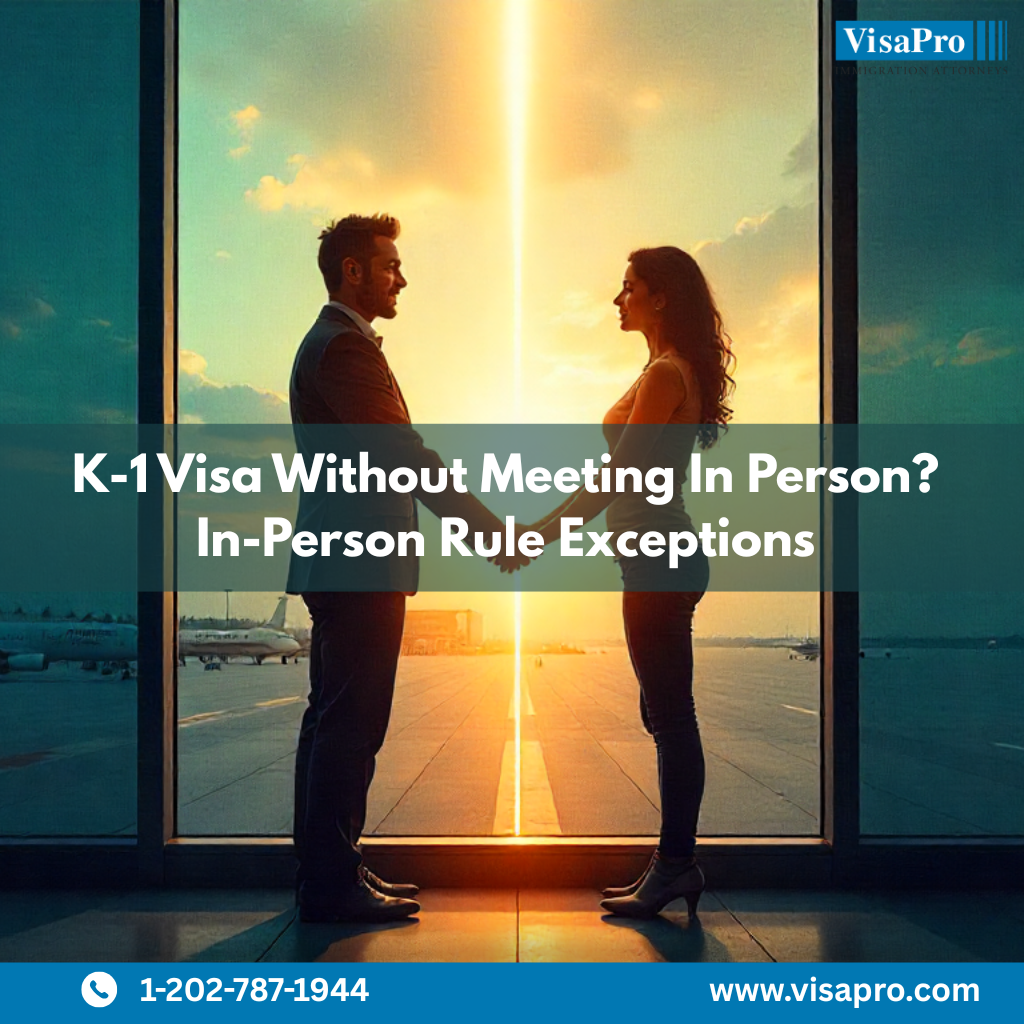
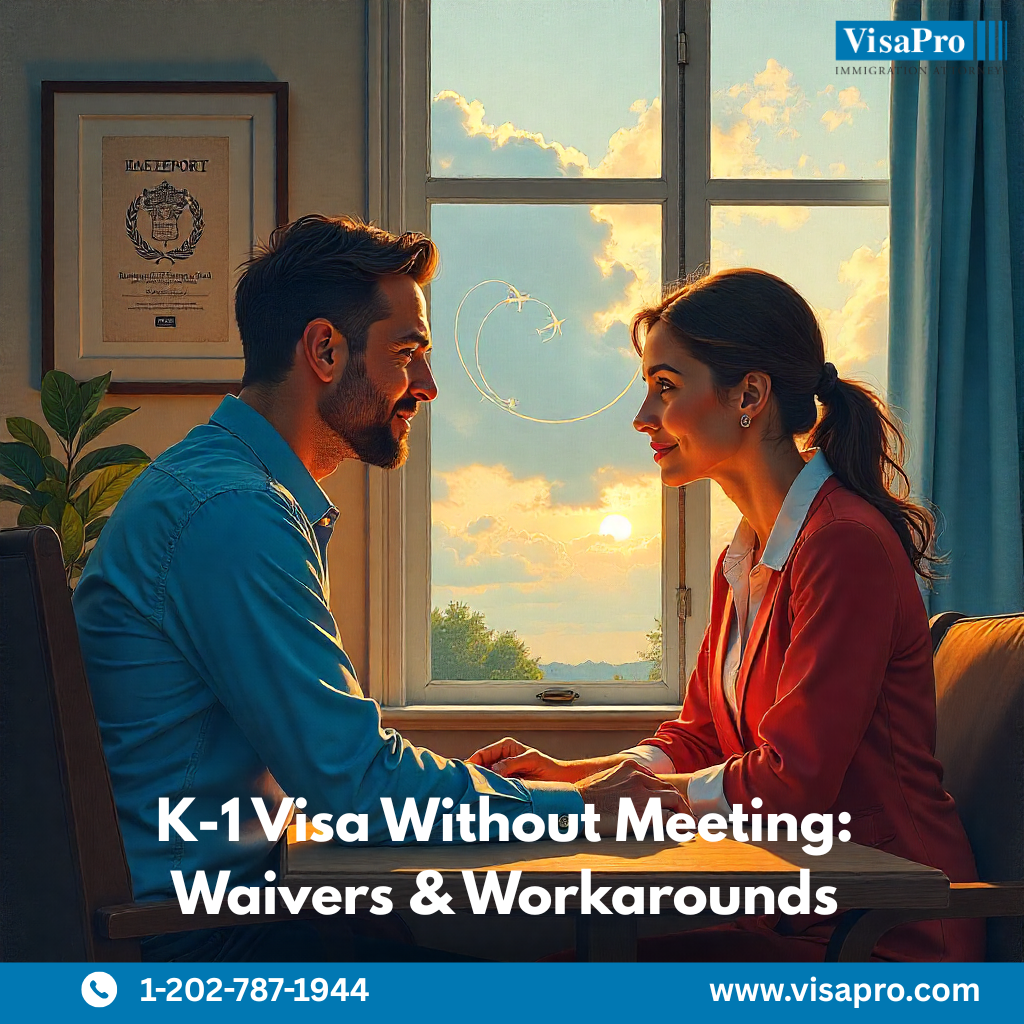
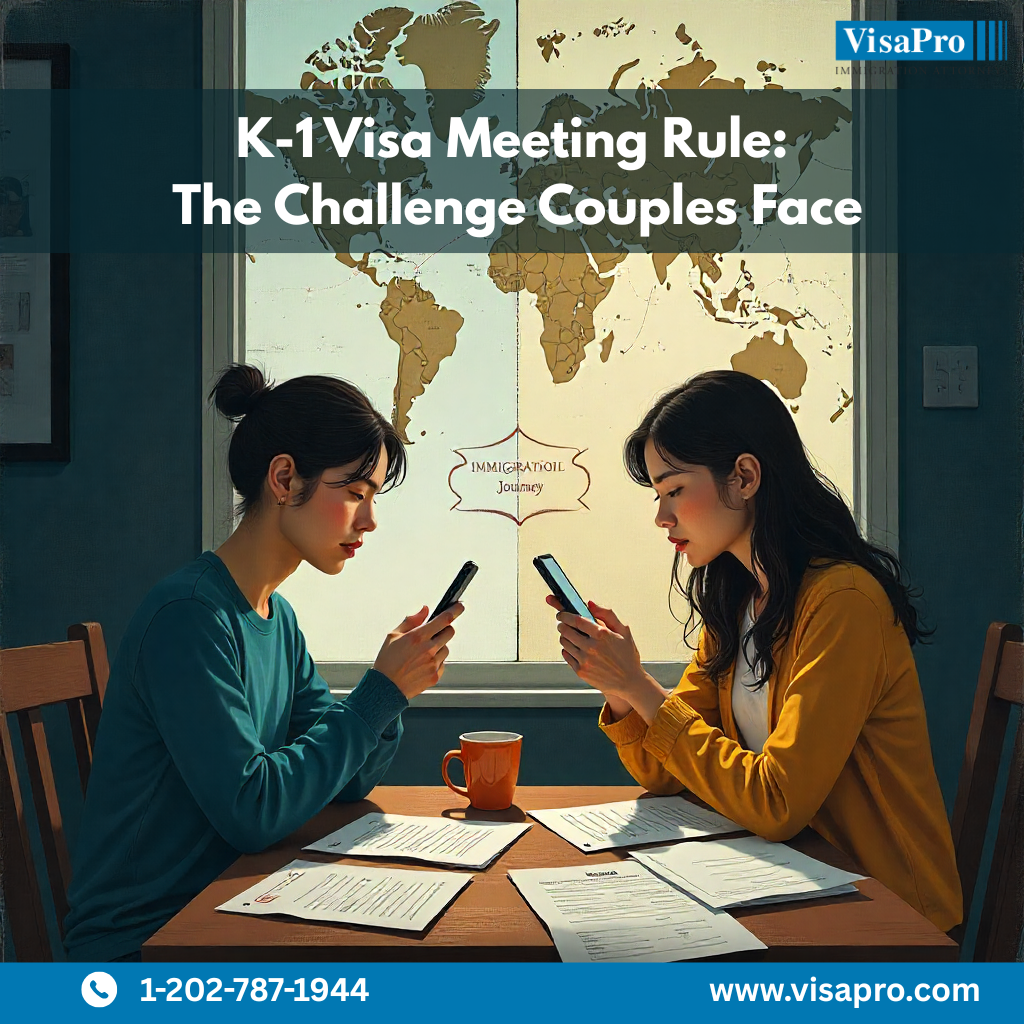
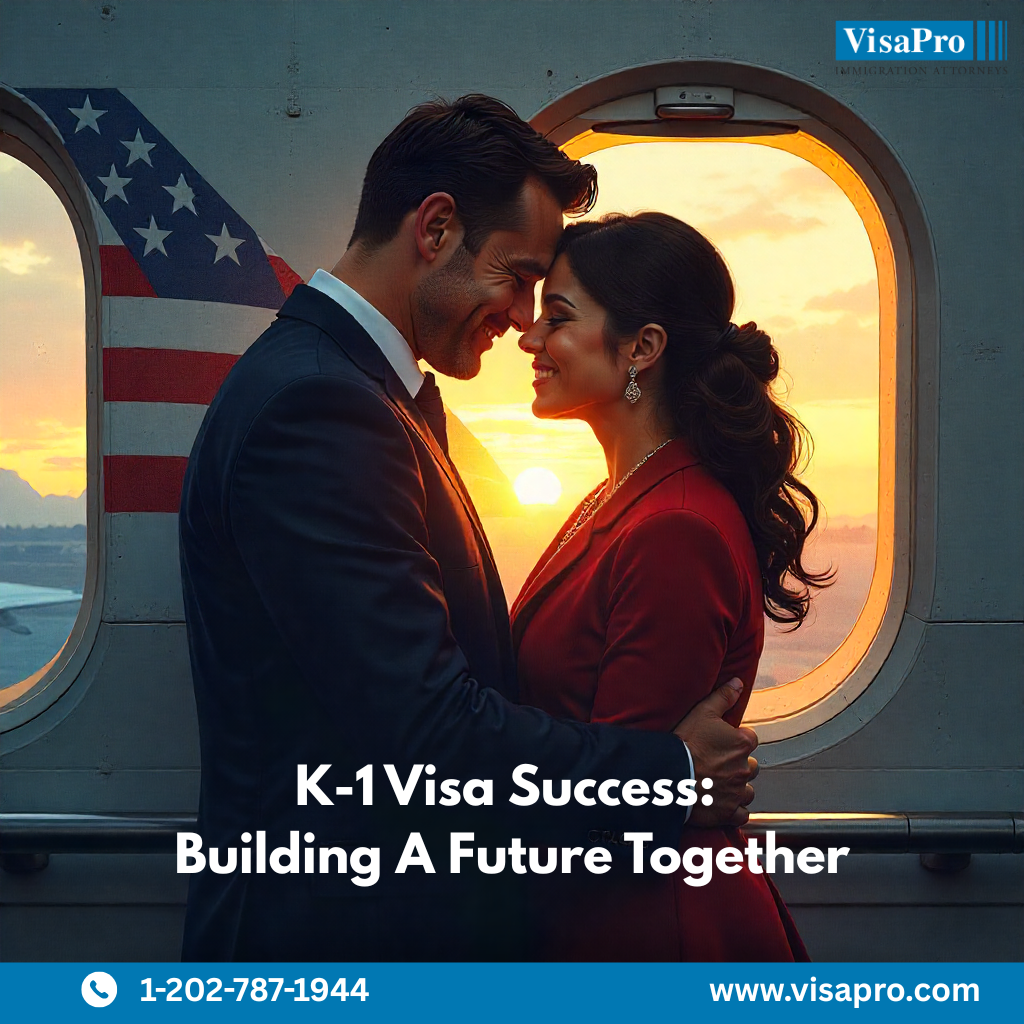
 Manas Bhat, Director Operations, First Houston Mortgage India
Manas Bhat, Director Operations, First Houston Mortgage India